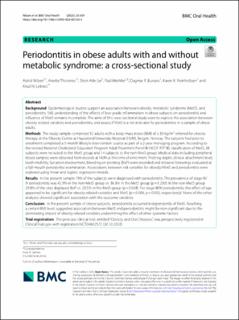| dc.contributor.author | Nilsen, Astrid | |
| dc.contributor.author | Thorsnes, Anette | |
| dc.contributor.author | Lie, Stein Atle | |
| dc.contributor.author | Methlie, Paal | |
| dc.contributor.author | Bunæs, Dagmar Fosså | |
| dc.contributor.author | Reinholtsen, Karen Knudsen | |
| dc.contributor.author | Leknes, Knut Norvald | |
| dc.date.accessioned | 2023-09-11T12:51:50Z | |
| dc.date.available | 2023-09-11T12:51:50Z | |
| dc.date.created | 2023-09-01T11:56:10Z | |
| dc.date.issued | 2023 | |
| dc.identifier.issn | 1472-6831 | |
| dc.identifier.uri | https://hdl.handle.net/11250/3088686 | |
| dc.description.abstract | Background
Epidemiological studies support an association between obesity, metabolic syndrome (MetS), and periodontitis. Still, understanding of the effects of low-grade inflammation in obese subjects on periodontitis and influence of MetS remains incomplete. The aims of this cross-sectional study were to explore the association between obesity related variables and periodontitis, and assess if MetS is a risk indicator for periodontitis in a sample of obese adults.
Methods
The study sample comprised 52 adults with a body mass index (BMI) of ≥ 30 kg/m2 referred for obesity therapy at the Obesity Centre at Haukeland University Hospital (HUH), Bergen, Norway. The subjects had prior to enrolment completed a 5-month lifestyle intervention course as part of a 2-year managing program. According to the revised National Cholesterol Education Program Adult Treatment Panel III (NCEP ATP III) classification of MetS, 38 subjects were recruited to the MetS group and 14 subjects to the non-MetS group. Medical data including peripheral blood samples were obtained from records at HUH at the time of enrolment. Probing depth, clinical attachment level, tooth mobility, furcation involvement, bleeding on probing (BoP) were recorded and intraoral bitewings evaluated at a full-mouth periodontal examination. Associations between risk variables for obesity/MetS and periodontitis were explored using linear and logistic regression models.
Results
In the present sample 79% of the subjects were diagnosed with periodontitis. The prevalence of stage III/IV periodontitis was 42.9% in the non-MetS group vs. 36.8% in the MetS group (p = 0.200). In the non-MetS group 29.8% of the sites displayed BoP vs. 23.5% in the MetS group (p = 0.048). For stage III/IV periodontitis, the effect of age appeared to be significant for obesity related variables and MetS (p = 0.006, p = 0.002, respectively). None of the other analyses showed significant association with the outcome variables.
Conclusion
In the present sample of obese subjects, periodontitis occurred independently of MetS. Reaching a certain BMI level, suggested association between MetS and periodontitis might be non-significant due to the dominating impact of obesity related variables undermining the effect of other systemic factors. | en_US |
| dc.language.iso | eng | en_US |
| dc.publisher | BMC | en_US |
| dc.rights | Navngivelse 4.0 Internasjonal | * |
| dc.rights.uri | http://creativecommons.org/licenses/by/4.0/deed.no | * |
| dc.title | Periodontitis in obese adults with and without metabolic syndrome: a cross-sectional study | en_US |
| dc.type | Journal article | en_US |
| dc.type | Peer reviewed | en_US |
| dc.description.version | publishedVersion | en_US |
| dc.rights.holder | Copyright 2023 The Author(s) | en_US |
| dc.source.articlenumber | 439 | en_US |
| cristin.ispublished | true | |
| cristin.fulltext | original | |
| cristin.qualitycode | 2 | |
| dc.identifier.doi | 10.1186/s12903-023-03133-5 | |
| dc.identifier.cristin | 2171625 | |
| dc.source.journal | BMC Oral Health | en_US |
| dc.identifier.citation | BMC Oral Health. 2023, 23 (1), 439. | en_US |
| dc.source.volume | 23 | en_US |
| dc.source.issue | 1 | en_US |

